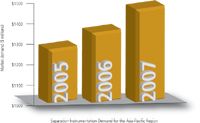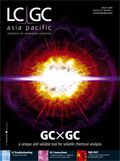National Symposium on Recent Advances in Analytical Sciences and Applications
The Indian Society of Analytical Scientists (ISAS) Delhi Chapter has announced that the National Symposium on Recent Advances in Analytical Sciences and Applications will be held at the Himachal Pradesh University (Summer Hills, Shimla, India) between 5–7 April 2007.
The Indian Society of Analytical Scientists (ISAS) Delhi Chapter has announced that the National Symposium on Recent Advances in Analytical Sciences and Applications will be held at the Himachal Pradesh University (Summer Hills, Shimla, India) between 5–7 April 2007.
ISAS is a scientific forum with its headquarters at BARC, Mumbai, India and has more than 2000 life members. The Delhi Chapter was established in 1992 and its headquarters are located at Indian Oil R&D Centre, Faridabad, giving it jurisdiction over mainly northern India. This Chapter has more than 700 life members from various research institutes, national laboratories, universities, industries and so on. In the past the Chapter has organized over 25 one/two-day technical seminars on various topics at diverse locations.
This three-day symposium has been organized in association with the Himachal Pradesh University. All the life members of ISAS are invited as well as other scientists working in the field of chemical and biological sciences to take part in this event.
Through the symposium the organizers aim to share the latest revelations in different analytical techniques with the scientists in academia, industries, national laboratories, teachers and students. The technical programme of the symposium will include both invited lectures, oral and poster presentations. Eminent scientists will deliver lectures highlighting advancements in different analytical techniques and their applications. Topics covered in the workshop will include atomic spectroscopy techniques, chromatography techniques, molecular spectroscopic techniques, mass spectrometry, hyphenated techniques and solid and liquid extraction techniques among others.
The event will be held in Shimla, which is also known as Queen of Hill Stations, and is the capital of the state of Himachal Pradesh. The Himachal Pradesh University was founded in 1970 and is located at Summer Hill, the Western end of Shimla approximately 5 km from the town. Weather is moderate but unpredictable in Shimla and the temperatures in the first week of April range from 15–20 °C.
For more information about this symposium and for full details on workshop topics please visit the organization's website at www.isasdelhi.org
Industry Profile: Separation Instrumentation Demand
Separation instrument techniques are among the most widely used technologies in the analytical instrumentation market. It spans the entire industrial and regional marketplace. The laboratory separations market includes chromatographic techniques such as analytical and preparative HPLC, GC, IC, TLC, flash and low-pressure LC.
The separation instrumentation market continues to expand, especially as global economic conditions strengthen. The growth in life science applications in both research and quality control has certainly had a positive impact on the separations market. Pharmaceutical and biotechnology companies have provided the stimulus for market growth during the last several years. These industries heavily rely on separation techniques to conduct their innovative research activities.

Separation Instrumentation Demand for the Asia-Pacific Region
While the demand of separation instruments is dependent on North America and Europe, which account for the majority of the separations market, the Asia-Pacific region, including Japan, China, India and Australia, is poised for robust growth over the next few years. Many of the top pharmaceutical and chemical companies are expanding their presence in this region, particularly in China and India. The Asia-Pacific region is known for its efficient manufacturing capabilities but is expected to play a stronger role in R&D activities as well.
India has been undergoing rapid technological and economic development. Because of the many fluent English speakers, India is more easily addressed by Western economies. Australia also offers strong growth opportunities, especially because its modern economy is much more heavily tied to Western Europe and the US.
Despite the progress in Southern Asia, this region is still considered to be somewhat risky for Western companies because of exchange rates, economic and political factors. Nonetheless, many separation instrument manufacturers are also establishing a stronger presence in the Asia-Pacific region by opening manufacturing and sales offices to take advantage of any potential this region has to offer.
The foregoing data was extracted from SDi's Market Analysis and Perspectives report titled SDi's Global Assessment Report, 9th Edition: The Laboratory Life Science & Analytical Instrumentation Industry (2006–2010). Contact Glenn Cudiamat, vice president of Research Services, Strategic Directions International Inc., 6242 Westchester Parkway, Suite 100, Los Angeles, California 90045, USA, tel. +1 310 641 4982, fax +1 310 641 8851, e-mail: cudiamat@strategic-directions.com

Regulatory Deadlines and Supply Chain Challenges Take Center Stage in Nitrosamine Discussion
April 10th 2025During an LCGC International peer exchange, Aloka Srinivasan, Mayank Bhanti, and Amber Burch discussed the regulatory deadlines and supply chain challenges that come with nitrosamine analysis.
Top Execs from Agilent, Waters, and Bruker Take the Stage at J.P. Morgan Healthcare Conference
January 16th 2025The 43rd Annual Healthcare J.P. Morgan Healthcare Conference kicked off in San Francisco earlier this week. Here’s what top executives from Agilent, Bruker, and Waters, discussed during the event.

.png&w=3840&q=75)

.png&w=3840&q=75)



.png&w=3840&q=75)



.png&w=3840&q=75)










